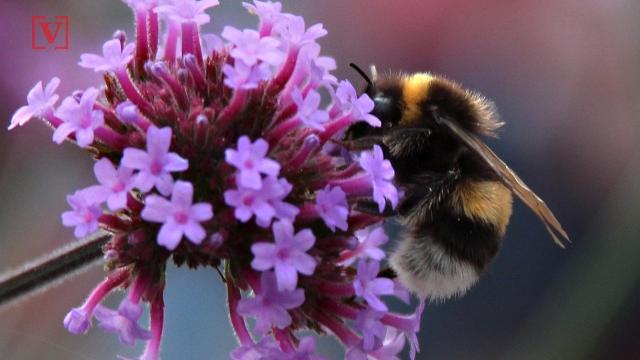World
World Bee Day is May 20. Here’s what to know about our fuzzy, utterly necessary friends

Bees make a big buzz while being relocated from the Florida Theatre
Tens of thousands of bees were removed from the walls of the building next to the Florida Theatre on April 28. Video provided by Paul Sifton, co-owner of Bee Friends Farms.
On Monday, May 20, we celebrate bees.
Lately, bees have been in the news for where they show up. About 20,000 bees and 70 pounds of honeycomb were removed from the building next to Jacksonville’s Florida Theater in April, the same month a Pennsylvania homeowner found thousands of them living in the walls of her home. A tennis match at the BNP Paribas Open was suspended for two hours when a bee swarm descended on the court. Last October, thousands of bees made a new home inside a cabinet near the Charlotte County Sheriff’s Office evidence lot.
And a beekeeper became an instant hero this month after racing across town to move a swarm that had formed behind home plate at Chase Field in Phoenix, Arizona, and held up the start of the game between the Los Angeles Dodgers and the Arizona Diamondbacks. Local pest control manager Matt Hilton arrived to thunderous applause and safely removed the swarm before waving to the crowd and throwing out the first pitch. Now he’s getting his own baseball card.
But bees are still threatened by human activity and land development, and since nearly 90% of the world’s flowering plant species depend at least partly on animal pollination from bees, butterflies, bats and hummingbirds the United Nations designated May 20 World Bee Day.
What is World Bee Day?
On December 20, 2017, the General Assembly of the U.N. adopted a resolution to create World Bee Day for all nations to educate citizens and raise awareness “of the importance of bees and other pollinators, the threats that they face and their contribution to sustainable development.”
The proposal from Slovenia chose May 20 to honor the birthday of the father of beekeeping, Anton Janša, born in 1734.
Why are bees important?

Bumble bee gathers pollen from a hosta
Here is a pollinator at work in a garden in Ipswich. The bumble bee gathers pollen from each flower it visits.
Wendall Waters, wickedlocal.com
Put simply, humans need them to survive.
Many species of plant depend on pollinators — animals or insects that move pollen from one flower to another — to reproduce. Bees are some of the most important and tireless pollinators as they fly from flower to flower gathering food for their offspring and incidentally helping plants spread their pollen, including more than 75% of the world’s food crops, according to the U.N.
“Today, every third spoonful of food depends on pollination,” the Republic of Slovenia’s World Bee Day site says, “and bee products are a rich source of essential nutrients.”
Many of our most common foods can’t reproduce without pollinators. Florida is home to over 300 species of bees, according to the Florida Department of Agriculture and Consumer Services, and a 2021 study found that insect pollinators are required or beneficial for nearly half of all plant crop species grown in the state.
Some of the major Florida crops that require insect pollinators include blueberries, mangoes, melons, squashes, and tangelos. Avocadoes, cucumbers, field tomatoes, grapefruits, green beans, oranges, peppers, southern peas, and strawberries require at least a moderate amount of insect pollination to survive and reproduce.
“The contribution of insect pollinators exceeds $50 million per crop per yr in Florida for 7 of its most valuable crops,” the study said.
Without bees and other pollinators, our food sources and biodiversity would dwindle, causing world hunger and a collapse of both the agricultural industry and local farmers.
Are bees threatened?

Wild bees are in decline, and the ecosystem could follow
Native bees are one of the lynchpins of the ecosystem and experts believe that their downfall could lead to ours. Veuer’s Justin Kircher has more.
Buzz60
Wild bee populations have been in decline for several years, although honey bee populations have been growing.
In 2021 the American bumblebee population had decreased by 89% over the previous two decades across the country and dropped to nearly zero in Maine, Rhode Island, New Hampshire, Vermont, Idaho, North Dakota, Wyoming, and Oregon and other major drops in New York and northern Illinois, according to a petition by the Center for Biological Diversity and Bombus Pollinators Association of Law Students to have the species listed as endangered.
Bee populations are threatened by:
- Climate change
- Pesticides
- Disease
- Habitat loss from large-scale changes in land use
- Invasive species such as African hornets
Are bees endangered?
Eight species of bees have officially been declared endangered: the rusty patched bumblebee and seven species of the Hawaiian yellow-faced bee.
What can I do to help bees?

How to make your yard inviting to bees, butterflies and hummingbirds
Many of Colorado’s native pollinators are in decline but here is how you can help the population rebound.
FairPlanet.org and the University of Florida’s IFAS Extension have some suggestions:
- Avoid using pesticides. If you must:
- Use them in the evening when bees are not as active
- Avoid spraying plants during bloom or when they’re flowering
- Use liquid, as powdered pesticides are more likely to stick to the bee
- Buy organic produce to encourage a market for food without pesticides
- Mow less and plant a variety of flowers and plants that bees pollinate
- Buy local honey to support local beekeepers
- Do not kill beehives, contact local registered beekeepers or pest control to safely move them
- Become a beekeeper yourself

No Mow May movement to help bees, other pollinators
The No Mow May movement helps pollinators become established and increase their numbers in a critical part of their life cycle, as they become active.
Wochit
There has been a growing movement in recent years to reduce the amount of lawn cultivation and chemical treatments by reducing how often homeowners mow their lawns. The idea is to create a more diverse and natural landscape, according to beecityusa,org.
May was chosen because it’s the start of the growing season and young bees can use the help. As urban and suburban development eats up bee habitats, flowers become harder and harder to find.
No Mow April, No Mow May, and Low Mow Spring are all ways to spread the word about allowing your yard to be more welcoming to pollinators. It was first popularized by U.K. organization Plantlife, but in 2020 residents of Appleton, Wisconsin asked the city council to suspend its weed ordinance for the month of May and the practice caught on.









